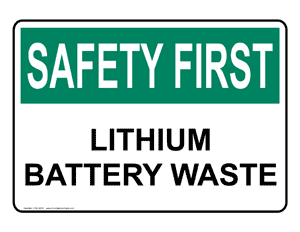
Lithium metal batteries waste is a safety puzzle in today’s green investing transactions. From manufacturers to freight forwarders, and recyclers to environmentalists, all look busy in conferencing to find out remedial solutions for this “universal waste“. The safe handling and storage of this hazardous waste is never a push technology which can be figured out with few clicks. But it requires warehousing practices echoing with the placard that “safety is our #1 priority“. And what makes a warehouse best for their safe storage? Regulated as class 9 dangerous goods (HAZMAT), following are the top eight practices for safe handling of used lithium metal batteries and cells:
1) DON’T expose to Environment
Handlers must NOT store the lithium waste in a place where this can be exposed to air because lithium contains combustible fumes, thereby, explosive in itself. And NOT to rule out that lithium gets highly violent when water dares to touch it. DON’T store the lithium waste near water. Even, a water fire-suppression system would amount to hazard. For humans, this waste is highly corrosive to their skin, nose, throat, stomach and eyes, hence protective clothing and personal protective equipment are highly recommended.
2) Quantity limits must not exceed
The quantity limits for lithium batteries waste is defined in terms of the size of storage facilities. The Small Quantity Handlers are allowed to store 5,000 Kilograms (11,000 pounds approx.) of the combined universal waste on-site, while the Large Quantity Handlers can store more than 5,000 but below than 20,000 kilograms of the combined on-site hazardous waste. It is a precondition for Large Quantity Handlers that they must submit a prior notification to the designated authority. However, there is no such condition for the Small Quantity Handlers.
Each container must bear clearly visible labels showing signs as “Universal Waste Batteries” or “Hazardous Waste”. Moreover, the labels must be affixed on the front dimensions of the lithium waste containers.
4) Accumulation time recording
The storage facility must not accumulate the lithium metal batteries waste more than one year. Labeled containers mentioning the start and end-dates of accumulation would account for good storage practices.
All personnel involved in handling this hazardous waste must be trained and certified to handle the dangerous goods. The operators must be trained for both onsite and offsite storage plans, waste classification, and in case of any emergency, they must have desired competency.
The standard operating procedures must be in place for firefighting particularly. Lith-X is a recommended fire extinguisher for lithium only. It is crucial to note that water, sand, and carbon dioxide must NOT be used for fire extinguishing of lithium waste. Lithium metals are particularly prone to re-ignition and thus, must NOT be ignored until the safety is certain. All the spill residues must be transferred to new containers and the leakage has to be cleaned immediately.
7) Avoid Doings
Heat must be avoided when storing lithium metal batteries waste. The temperature of the warehouse must not exceed more than room temperature. Safety equipment be used when handling the waste. The storage facility must be located in a remote area far from residential premises. The shocks and jerks must be avoided while lifting the containers including waste. And not to mention, smoking is unacceptable.
8) Compliance is the best practice
All the relevant regulations must be accorded to demonstrate an absolute compliance and for this purpose, both national and international regulations must be strictly followed.


